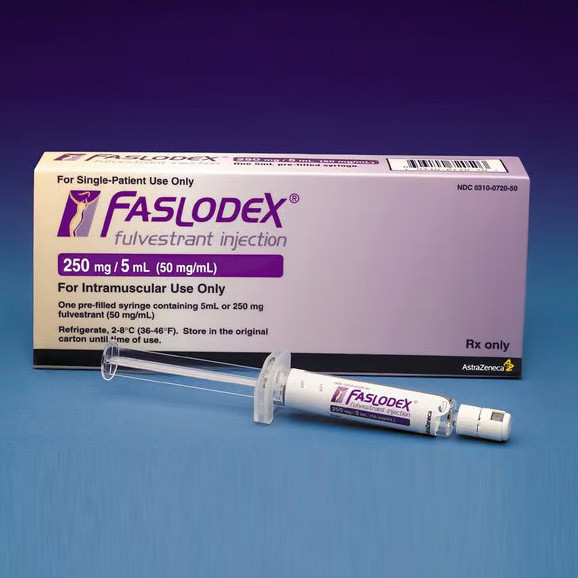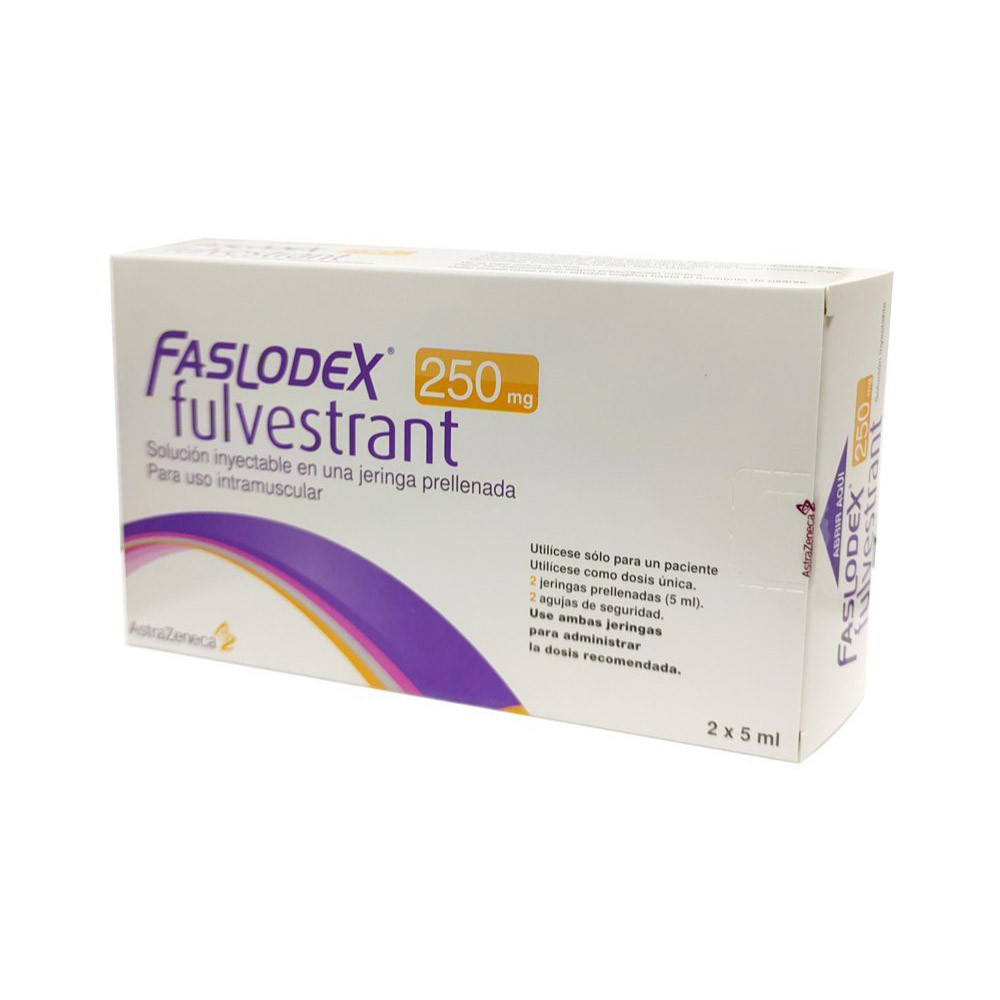5 ml pre-filled syringe:
৳ 25,000.00
(2's pack: ৳ 50,000.00)
Indications
Faslodex is an estrogen receptor antagonist indicated for the treatment of:
- Hormone receptor (HR)-positive, human epidermal growth factor receptor 2 (HER2)-negative advanced breast cancer in postmenopausal women not previously treated with endocrine therapy.
- HR-positive advanced breast cancer in postmenopausal women with disease progression following endocrine therapy.
- HR-positive, HER2-negative advanced or metastatic breast cancer in postmenopausal women in combination with ribociclib, as initial endocrine based therapy or following disease progression on endocrine therapy.
- HR-positive, HER2-negative advanced or metastatic breast cancer in combination with palbociclib or abemaciclib in women with disease progression after endocrine therapy.
* রেজিস্টার্ড চিকিৎসকের পরামর্শ মোতাবেক ঔষধ সেবন করুন
Pharmacology
Many breast cancers have estrogen receptors (ER) and the growth of these tumors can be stimulated by estrogen. Fulvestrant is an estrogen receptor antagonist that binds to the estrogen receptor in a competitive manner with affinity comparable to that of estradiol and downregulates the ER protein in human breast cancer cells.
In vitro studies demonstrated that fulvestrant is a reversible inhibitor of the growth of tamoxifen-resistant, as well as estrogen-sensitive human breast cancer (MCF-7) cell lines. In in vivo tumor studies, fulvestrant delayed the establishment of tumors from xenografts of human breast cancer MCF-7 cells in nude mice. Fulvestrant inhibited the growth of established MCF-7 xenografts and of tamoxifen-resistant breast tumor xenografts.
Fulvestrant showed no agonist-type effects in in vivo uterotrophic assays in immature or ovariectomized mice and rats. In in vivo studies in immature rats and ovariectomized monkeys, fulvestrant blocked the uterotrophic action of estradiol. In postmenopausal women, the absence of changes in plasma concentrations of FSH and LH in response to fulvestrant treatment (250 mg monthly) suggests no peripheral steroidal effects.
In vitro studies demonstrated that fulvestrant is a reversible inhibitor of the growth of tamoxifen-resistant, as well as estrogen-sensitive human breast cancer (MCF-7) cell lines. In in vivo tumor studies, fulvestrant delayed the establishment of tumors from xenografts of human breast cancer MCF-7 cells in nude mice. Fulvestrant inhibited the growth of established MCF-7 xenografts and of tamoxifen-resistant breast tumor xenografts.
Fulvestrant showed no agonist-type effects in in vivo uterotrophic assays in immature or ovariectomized mice and rats. In in vivo studies in immature rats and ovariectomized monkeys, fulvestrant blocked the uterotrophic action of estradiol. In postmenopausal women, the absence of changes in plasma concentrations of FSH and LH in response to fulvestrant treatment (250 mg monthly) suggests no peripheral steroidal effects.
Dosage & Administration
Fulvestrant 500 mg should be administered intramuscularly into the buttocks (gluteal area) slowly (1-2 minutes per injection) as two 5 mL injections, one in each buttock, on Days 1, 15, 29, and once monthly thereafter.
A dose of 250 mg is recommended in patients with moderate hepatic impairment to be administered intramuscularly into the buttock (gluteal area) slowly (1-2 minutes) as one 5 mL injection on Days 1, 15, 29, and once monthly thereafter.
Pediatric Use: Safety and effectiveness in pediatric patients have not been established.
A dose of 250 mg is recommended in patients with moderate hepatic impairment to be administered intramuscularly into the buttock (gluteal area) slowly (1-2 minutes) as one 5 mL injection on Days 1, 15, 29, and once monthly thereafter.
Pediatric Use: Safety and effectiveness in pediatric patients have not been established.
* রেজিস্টার্ড চিকিৎসকের পরামর্শ মোতাবেক ঔষধ সেবন করুন
Interaction
There are no known drug-drug interactions. Although Faslodex is metabolized by CYP 3A4 in vitro, drug interaction studies with ketoconazole or rifampin did not alter Faslodex pharmacokinetics. Dose adjustment is not needed in patients co-prescribed CYP 3A4 inhibitors or inducers.
Side Effects
The most common adverse reactions occurring in ≥5% of patients receiving Faslodex 500 mg were: injection site pain, nausea, bone pain, arthralgia, headache, back pain, fatigue, pain in extremity, hot flash, vomiting, anorexia, asthenia, musculoskeletal pain, cough, dyspnea, and constipation.
Increased hepatic enzymes (ALT, AST, ALP) occurred in >15% of Faslodex patients and were not dose-dependent.
Increased hepatic enzymes (ALT, AST, ALP) occurred in >15% of Faslodex patients and were not dose-dependent.
Pregnancy & Lactation
There are no available data in pregnant women to inform the drug-associated risk. There is no information regarding the presence of fulvestrant in human milk, nor of its effects on milk production or breastfed infant.
Precautions & Warnings
Risk of Bleeding: Use with caution in patients with bleeding diatheses, thrombocytopenia, or anticoagulant use.
Increased Exposure in Patients with Hepatic Impairment: Use a 250 mg dose for patients with moderate hepatic impairment.
Injection Site Reaction: Use caution while administering Faslodex at the dorsogluteal injection site due to the proximity of the underlying sciatic nerve.
Embryo-Fetal Toxicity: Can cause fetal harm. Advise females of reproductive potential of the potential risk to a fetus and to use effective contraception.
Immunoassay Measurement of Serum Estradiol: Faslodex can interfere with estradiol measurement by immunoassay, resulting in falsely elevated estradiol levels.
Increased Exposure in Patients with Hepatic Impairment: Use a 250 mg dose for patients with moderate hepatic impairment.
Injection Site Reaction: Use caution while administering Faslodex at the dorsogluteal injection site due to the proximity of the underlying sciatic nerve.
Embryo-Fetal Toxicity: Can cause fetal harm. Advise females of reproductive potential of the potential risk to a fetus and to use effective contraception.
Immunoassay Measurement of Serum Estradiol: Faslodex can interfere with estradiol measurement by immunoassay, resulting in falsely elevated estradiol levels.
Overdose Effects
Human experience of overdose with Faslodex is limited. There are isolated reports of overdose with Faslodex in humans. No adverse reactions were seen in healthy male and female volunteers who received intravenous Faslodex, which resulted in peak plasma concentrations at the end of the infusion, that were approximately 10 to 15 times those seen after intramuscular injection. The potential toxicity of Faslodex at these or higher concentrations in cancer patients who may have additional comorbidities is unknown. There is no specific treatment in the event of Faslodex overdose, and symptoms of overdose are not established. In the event of an overdose, healthcare practitioners should follow general supportive measures and should treat symptomatically.
Therapeutic Class
Cytotoxic Chemotherapy
Storage Conditions
Refrigerate 2°-8°C. To protect from light, store in the original carton until the time of use.
Pack Images: Faslodex 250 mg Injection


